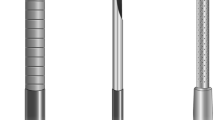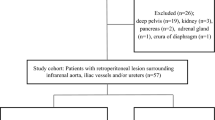Abstract
Purpose
To evaluate the diagnostic yield, safety, and factors associated with the diagnostic yield of percutaneous core needle biopsy (PNB) for peritoneal/omental lesions.
Methods
Consecutive 297 patients (67 men, 230 women; median age, 64 years [range 15–87]) who underwent a PNB for 311 peritoneal/omental lesions at a single center from April 2010 to March 2020 were evaluated retrospectively. The preprocedural CT findings, diagnostic yield, sensitivity, specificity, PPV, NPV, technical success rate, and adverse events were analyzed. Surgical or clinical diagnosis with follow-up was the diagnostic reference standard. Adverse events were evaluated using the Society of Interventional Radiology guidelines.
Results
The median anteroposterior (AP) diameter and CT value of the target lesion were 24 mm (range 5–78) and 46 HU (range − 75 to 140), respectively. Ascites was interposed on the puncture route in 106 patients (34.1%). The technical success rate was 100%. The diagnostic yield, sensitivity, specificity, PPV, and NPV were 93.9%, 93.8%, 100%, 100%, and 20.8%, respectively. Minor complications were observed following five procedures (1.6%). The diagnostic yield was lower for fat-dominant lesions than for other lesions (82.6% vs. 95.8%, p = 0.002). The diagnostic PNB group had a greater AP diameter than did the non-diagnostic PNB group (27.3 ± 13.0 vs. 20.7 ± 8.4 mm, p = 0.037).
Conclusion
PNB for peritoneal/omental lesions provided a sufficiently high diagnostic yield and minimal adverse events. Lesions with a greater AP diameter and a higher density on CT would provide more diagnostic specimens from this technique.




Similar content being viewed by others
Abbreviations
- AP:
-
Anteroposterior
- PNB:
-
Percutaneous core needle biopsy
References
Sadeghi B, Arvieux C, Glehen O et al (2000) Peritoneal carcinomatosis from non-gynecologic malignancies: results of the EVOCAPE 1 multicentric prospective study. Cancer 88:358-363
Coccolini F, Gheza F, Lotti M et al (2013) Peritoneal carcinomatosis. World J Gastroenterol 19:6979-6994
Network NCC (2020) NCCN Clinical Practice Guidelines in Oncology (NCCN Guidelines), Ovarian Cancer, Including Fallopian Tube Cancer and Primary Peritoneal Cancer version 1.2020. Available via https://www.nccn.org/professionals/physician_gls/pdf/ovarian.pdf. Accessed 12 June 2020
Vergote I, Trope CG, Amant F et al (2010) Neoadjuvant chemotherapy or primary surgery in stage IIIC or IV ovarian cancer. New England Journal of Medicine 363:943-953
Yin WJ, Zheng GQ, Chen YF et al (2016) CT differentiation of malignant peritoneal mesothelioma and tuberculous peritonitis. Radiol Med 121:253-260
Ruess L, Frazier AA, Sivit CJ (1995) CT of the mesentery, omentum, and peritoneum in children. Radiographics 15:89-104
Rodriguez E, Pombo F (1996) Peritoneal tuberculosis versus peritoneal carcinomatosis: distinction based on CT findings. Journal of Computer Assisted Tomography 20:269-272
Neill AC, Shinagare AB, Rosenthal MH, Tirumani SH, Jagannathan JP, Ramaiya NH (2014) Differences in CT features of peritoneal carcinomatosis, sarcomatosis, and lymphomatosis: retrospective analysis of 122 cases at a tertiary cancer institution. Clinical Radiology 69:1219-1227
Liang YF, Zheng GQ, Chen YF, Song H, Yin WJ, Zhang L (2016) CT differentiation of diffuse malignant peritoneal mesothelioma and peritoneal carcinomatosis. Journal of Gastroenterology and Hepatology 31:709-715
Karaosmanoglu D, Karcaaltincaba M, Oguz B, Akata D, Ozmen M, Akhan O (2009) CT findings of lymphoma with peritoneal, omental and mesenteric involvement: peritoneal lymphomatosis. European Journal of Radiology 71:313-317
Caplan E, Deputy M, Arul D, Wilson J (2019) Actinomycosis of the omentum with invasion of the abdominal wall, small bowel and transverse colon mimicking malignancy. BMJ Case Rep 12
Chan YL, Cheng CS, Ng PW (1993) Mesenteric actinomycosis. Abdominal Imaging 18:286-287
Thabet A, Somarouthu B, Oliva E, Gervais DA, Hahn PF, Lee SI (2014) Image-guided ovarian mass biopsy: efficacy and safety. Journal of Vascular and Interventional Radiology 25:1922-1927 e1921
Spencer JA, Swift SE, Wilkinson N, Boon AP, Lane G, Perren TJ (2001) Peritoneal carcinomatosis: image-guided peritoneal core biopsy for tumor type and patient care. Radiology 221:173-177
Froelich JJ, Ishaque N, Regn J, Saar B, Walthers EM, Klose KJ (2002) Guidance of percutaneous pulmonary biopsies with real-time CT fluoroscopy. European Journal of Radiology 42:74-79
Odisio BC, Tam AL, Avritscher R, Gupta S, Wallace MJ (2012) CT-guided adrenal biopsy: comparison of ipsilateral decubitus versus prone patient positioning for biopsy approach. European Radiology 22:1233-1239
Tomozawa Y, Inaba Y, Yamaura H et al (2011) Clinical value of CT-guided needle biopsy for retroperitoneal lesions. Korean J Radiol 12:351-357
Vadvala HV, Furtado VF, Kambadakone A, Frenk NE, Mueller PR, Arellano RS (2017) Image-Guided Percutaneous Omental and Mesenteric Biopsy: Assessment of Technical Success Rate and Diagnostic Yield. Journal of Vascular and Interventional Radiology 28:1569-1576
Gupta S, Wallace MJ, Cardella JF et al (2010) Quality improvement guidelines for percutaneous needle biopsy. Journal of Vascular and Interventional Radiology 21:969-975
Morgan RJ, Jr., Armstrong DK, Alvarez RD et al (2016) Ovarian Cancer, Version 1.2016, NCCN Clinical Practice Guidelines in Oncology. J Natl Compr Canc Netw 14:1134-1163
Spencer JA, Weston MJ, Saidi SA, Wilkinson N, Hall GD (2010) Clinical utility of image-guided peritoneal and omental biopsy. Nat Rev Clin Oncol 7:623-631
Hill DK, Schmit GD, Moynagh MR, Nicholas Kurup A, Schmitz JJ, Atwell TD (2017) Percutaneous omental biopsy: efficacy and complications. Abdom Radiol (NY) 42:1566-1570
Hewitt MJ, Anderson K, Hall GD et al (2007) Women with peritoneal carcinomatosis of unknown origin: Efficacy of image-guided biopsy to determine site-specific diagnosis. BJOG 114:46-50
Pombo F, Rodriguez E, Martin R, Lago M (1997) CT-guided core-needle biopsy in omental pathology. Acta Radiologica 38:978-981
Souza FF, Mortele KJ, Cibas ES, Erturk SM, Silverman SG (2009) Predictive value of percutaneous imaging-guided biopsy of peritoneal and omental masses: results in 111 patients. AJR American Journal of Roentgenology 192:131-136
Lee JK, Baek SY, Lim SM, Lee KH (2011) Reticular infiltrations alone without mass in the mesentery and omentum identified at contrast-enhanced CT: efficacy of US-guided percutaneous core biopsy. Radiology 261:311-317
Ring EJ, Kerlan RK, Jr. (1984) Interventional biliary radiology. AJR American Journal of Roentgenology 142:31-34
Sacks D, McClenny TE, Cardella JF, Lewis CA (2003) Society of Interventional Radiology clinical practice guidelines. Journal of Vascular and Interventional Radiology 14:S199-202
Kaspar HG, Crum CP (2015) The utility of immunohistochemistry in the differential diagnosis of gynecologic disorders. Archives of Pathology and Laboratory Medicine 139:39-54
Lin F, Liu H (2014) Immunohistochemistry in undifferentiated neoplasm/tumor of uncertain origin. Archives of Pathology and Laboratory Medicine 138:1583-1610
Uehara T, Yoshida H, Fukuhara M et al (2020) Efficacy of ascitic fluid cell block for diagnosing primary ovarian, peritoneal, and tubal cancer in patients with peritoneal carcinomatosis with ascites. Gynecologic Oncology 157:398-404
Acknowledgments
The guarantor of this research is Miyuki Sone. This study was approved by the relevant institutional review board of a National Cancer Center Hospital (2020-074). This work was supported by the National Cancer Center Research and Development Fund (31-A-13); National Cancer Center under the National Cancer Center Research and Development Fund (29-A-11); research grant from Canon Medical Systems; and the Japan Agency for Medical Research and Development (AMED) under the Practical Research for Innovative Cancer Control Grant (16ck0106058h0003). The results of the PNB for 81 patients have been reported in a previous study [31]. The earlier study evaluated the diagnostic yield of the ascitic fluid cell block in patients with gynecological malignancies and compared it with that of PNB and the CA125/CEA ratio in ascites. The current study focused on the diagnostic yield of PNB for peritoneal/omental lesions caused by various diseases and evaluated the factors associated with the diagnostic yield in a larger study population.
Funding
Funding was provided by National Cancer Center Research and Development Fund (29-A-11), National Cancer Center Research and Development Fund (31-A-13), Canon Medical Systems and Japan Agency for Medical Research and Development (16ck0106058h0003).
Author information
Authors and Affiliations
Corresponding author
Additional information
Publisher's Note
Springer Nature remains neutral with regard to jurisdictional claims in published maps and institutional affiliations.
Rights and permissions
About this article
Cite this article
Sugawara, S., Sone, M., Itou, C. et al. Analysis of factors affecting the diagnostic yield of image-guided percutaneous core needle biopsy for peritoneal/omental lesions. Abdom Radiol 46, 4499–4508 (2021). https://doi.org/10.1007/s00261-021-03088-7
Received:
Revised:
Accepted:
Published:
Issue Date:
DOI: https://doi.org/10.1007/s00261-021-03088-7




